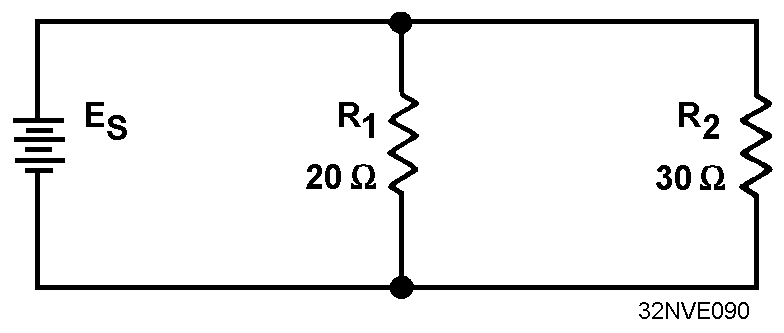Original post by thefatone
In a circuit where there are 2 resistors in parallel do they have the same voltage flowing through them no matter the resistance?
Voltage doesnt really flow as such, but the voltage across them woukd be the same (provided they are the only component in each branch)
Original post by samb1234
Voltage doesnt really flow as such, but the voltage across them woukd be the same (provided they are the only component in each branch)
thanks, my mistake
so for example in this random pic i got off the interwebs the voltage across both resistors would be the same?
Original post by thefatone
thanks, my mistake
so for example in this random pic i got off the interwebs the voltage across both resistors would be the same?

so for example in this random pic i got off the interwebs the voltage across both resistors would be the same?
Yup, the potential difference across each resistor is the same
 it's just the current (and hence power dissipated) which is different.
it's just the current (and hence power dissipated) which is different.Original post by thefatone
thanks, my mistake
so for example in this random pic i got off the interwebs the voltage across both resistors would be the same?

so for example in this random pic i got off the interwebs the voltage across both resistors would be the same?
Yes it would be. Just a tip for questions involving lightbulbs, a fairly common question is where they have 2 bulbs and one is brighter in series and the other is brighter when in parallel, and they ask you to explain why/which has the higher resistance. Remember that the brightness is essentially a measure of the power dissipated, and you hopefully know that p=v^2/r or P=I^2 R. In series, I is constant so using the second we can easily see that the bulb with the higher resistance is brighter. In parallel, the voltage is the same so we can see that the one with the higher resistance will be less bright from the first equation
Original post by samb1234
Yes it would be. Just a tip for questions involving lightbulbs, a fairly common question is where they have 2 bulbs and one is brighter in series and the other is brighter when in parallel, and they ask you to explain why/which has the higher resistance. Remember that the brightness is essentially a measure of the power dissipated, and you hopefully know that p=v^2/r or P=I^2 R. In series, I is constant so using the second we can easily see that the bulb with the higher resistance is brighter. In parallel, the voltage is the same so we can see that the one with the higher resistance will be less bright from the first equation
thanks help here too pls
http://www.thestudentroom.co.uk/showthread.php?t=4068687&p=64659801#post64659801
Quick Reply
Related discussions
- electric circuit question
- resistance in a parallel circuit
- Help! Electricity igcse physics qs make no sense
- How does the variable resistor circuit provide a larger current?
- Impedance
- Electrical
- Confusing Capacitor question
- LDR's in GCSE physics
- BTEC Applied science Unit 3 2022 Exam
- physics alevel edexcel circuit question
- Question about parallel circuit- OCR AS physics
- Physics Alevel question :- electromagnetism induction and alternating current
- Electricity - Calculating currents & Voltages etc
- HNC electrical engineering
- need help please!
- Use a simulator to plot the frequency response of the circuit
- NEA game ideas
- A level physics electricity
- HNC Electrical engineering
- Electricity question help




